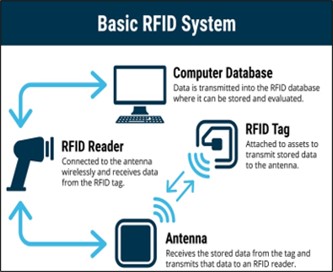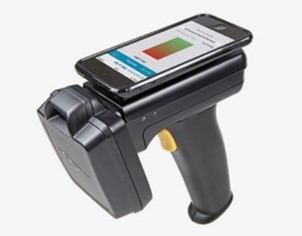The Federal Highway Administration's (FHWA) State Transportation Innovation Council (STIC) Incentive Program continues to help Pennsylvania advance innovations, making it easier for PennDOT to deliver more timely and efficient transportation services to the traveling public.
With up to $100,000 per year from FHWA, the STIC Incentive Program has supported such recent advances in extending bridge life as well as innovative construction and inspection approaches.
The Radio-Frequency Identification (RFID) Tags Test Usage pilot project was selected to receive STIC Incentive Program funding in 2022. The goal of the project is to investigate the potential use of RFID tags for various PennDOT assets. By scanning an RFID tag, limitless data about the product to which it is attached becomes accessible.
For example, a precast concrete tag could display the manufacturer, date cast, test results, material certification, etc. Onsite material samples could be tagged and sent for testing where the tag is scanned to receive details about the sample. Once completed, data could be deleted, and the tag sent back out for use. Tags could also be used by maintenance forces when permanent items, such as signs, structures, guiderail, etc., are tagged.
John Myler, assistant construction manager, PennDOT District 11, is overseeing the pilot project. Two additional District 11 employees, James Hontz, district materials manager and Dean Poleti, P.E., maintenance service engineer, are assisting with integrating RFID tags with PennDOT technology, along with Phil Petrina, a program analyst in the Bureau of IT Project Development and Delivery. Additionally, a consultant team from WSP, including Lou Ruzzi, P.E., Chris Mills, RCDD, and Bill Fabrizi, P.E., are also contributing to the work on this project.
What is RFID?
RFID is a wireless, non-contact system that uses radio-frequency electromagnetic fields to automatically identify and track tags attached to objects. The system is comprised of two components – tags and readers. The reader is a device that has one or more antennas that emit radio waves and receive signals back form the RFID tag. Some examples of where RFID tags are found are in credit cards, car key fobs, and access control badges.
There are two types of RFID tags – passive and active.
Passive tags require no battery and are powered to read at short ranges via magnetic fields. The tag contains electronically stored information that can be read up to several feet away. Since a passive RFID tag does not have any power source, an RFID reader within range is needed.
Active RFID tags are continuously operating, battery-powered sensors that gather and transmit data to a reading device. Unlike a passive tag, an active RFID tag has an onboard, long-lasting battery that enables the tag to transmit data continuously, regardless of whether it's in the field range of a reader.
For the purposes of the pilot project, Myler and his project team, are using passive RFID tags. Each tag has a unique identifying number that correlates to the information being stored about the asset in a backend database.

Why RFID?
With PennDOT's e-Construction and Partnering efforts and its Digital Delivery Directive 2025 initiative, Myler noted that the use of technology will continue to expand at PennDOT, along with the need to collect and store even more data moving forward.
With the replacement of paper processes and the need to capture and store this data in these systems of record, Myler believes the use of RFID tags is an additional opportunity for PennDOT to leverage more of the data collected in the future.
"The Proof is in the Tagging"
Since RFID is a mature technology and has been used a lot of different ways in a lot of different places, Myler and the project team began their evaluation by conducting outreach to other states and industry partners to collect and build upon lessons learned and eventually customize the technology to fit PennDOT's needs.
The team also evaluated the RFID tags and readers to see how they would perform in a variety of conditions.
"There are seven factors that we looked at to evaluate RFID tags," Mills said. "We evaluated them for frequency range, environment, mounting services, size, attachment method, reading range, and memory storage."
For example, the tags were put under water, in concrete and asphalt, and baked in an asphalt oven at 320 degrees, none of which damaged the tags. "This shows the quality and the ruggedness of these tags and that they can have a long-life span in many different situations encountered on a construction site," Myler said.
The RFID readers were also evaluated to ensure inspectors have a device that won't break if it falls, and is Ingress Protection (IP) rated, which means it is effectively sealed from the elements. The team also tested reading capabilities of the tags through walls and evaluated Bluetooth and Wi-Fi connections to ensure secure data transmission and access to asset information.
Through the evaluation, the team noted some limitations that prevented reading some of the tags. For example, most tags cannot be read through steel; although, there are some tags that have a metallic side and when placed on a sign, it uses the steel of the sign to amplify the signal.
"It requires learning what these different RFID tags are used for and understanding the limitations each one has versus another," Myler said. "All tags have benefits depending on how you intend to use them. Some tags can be recycled and reused, some can be read without seeing them, and most are durable and can last over time."


What's Next?
The next phase of the project is determining where to store the data being collected. A software application that translates the unique identifier to the asset and all the information that's included is needed for future use of the RFID tags.
"There are several options to explore regarding storing this data," Myler said. "We are looking at off-the-shelf products as well as the possibility of developing an internal system that can be customized, or maybe a hybrid solution."
According to Myler, additional next steps include
- Procurement of RFID tags and readers for each PennDOT district and central office
- Development of a program management initiative for RFID statewide implementation
- Development of standard operating procedures for the RFID program
- Development of a user manual for the RFID program
- Development of training procedures for application of tags and use of readers, and data management
- Develop RFID tag options for varied use cases
Myler shared that the STIC Incentive Program funding is being utilized to purchase two RFID readers for each PennDOT district. Along with the readers, each district will receive a handful of RFID tags and guidance on how to connect the reader to Bluetooth. The team is also working on getting the applications approved within the PennDOT app catalog, so employees can access this software on department devices. The hope is that eventually PennDOT partners, including local government, can benefit from this technology as well.
"With these types of technology solutions, it's beneficial to take very small steps," Myler said. "We want to make sure there is a good return on our investment and that it's a program that makes sense. We want this to be an innovative solution for PennDOT and our partners."
